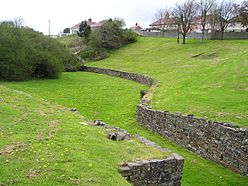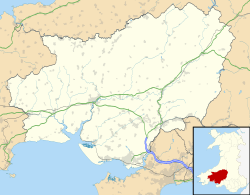Moridunum (Carmarthen) facts for kids
Quick facts for kids Moridunum |
|
|---|---|

Roman amphitheatre at Carmarthen
|
|
| Alternative name(s) | Moridunum Demetarum |
| Known also as | Carmarthen |
| Founded | c. 75 AD |
| Place in the Roman world | |
| Province | Britannia |
| Structure | |
| — Stone structure — | |
| Location | |
| Coordinates | 51°52′N 4°19′W / 51.86°N 4.31°W |
| Town | Carmarthen |
| County | Carmarthenshire |
| Country | Wales |
| Reference | |
| UK-OSNG reference | SN4020 |
Moridunum was an important Roman fort and town in the ancient Roman province of Britannia. Today, we know this place as Carmarthen. It is located in the beautiful Welsh county of Carmarthenshire.
Contents
The Roman Fort of Moridunum
Moridunum means "sea fort" in Latin. It was the main city, or civitas capital, for the Demetae tribe in Roman Wales. Ancient writers like Ptolemy mentioned it.
The first Roman fort, called a castra, was likely built around 75 AD. It might have replaced an older hillfort on Merlin's Hill. This fort was used until about 120 AD. After that, the civilian settlement next to it, called a vicus, grew into a proper town.
A map from 1723 by William Stukeley shows Moridunum (Carmarthen) at the very end of the Roman road system in Southern Wales. This shows how important it was for travel and trade.
Life in the Roman Town
The Roman town of Moridunum was carefully planned. It had a street-grid layout, like a checkerboard. The Romans built a public bath house where people could wash and relax. There might have also been a mansio, which was like a guesthouse for travelers.
The main public square, called the forum, and a large public building, the basilica, were probably in the busiest part of today's Carmarthen. This area was along the cardo, which was the main street. Along the streets, there were narrow shops. We also know that people worked with metal there.
At first, many homes were made of timber. But by the late 3rd or early 4th century, larger houses were rebuilt using stone. Archaeologists have also found a Roman temple from the 1st or 2nd century. It was built in a special Romano-Celtic style, mixing Roman and Celtic ideas.
To protect the town, a large earth bank and ditch were built around it in the mid-2nd century. Later, a strong stone wall was added for even more protection.
The Roman Amphitheatre
Just east of the old town, you can find one of only seven Roman amphitheatres still existing in the United Kingdom. This is the only Roman structure in Carmarthen that you can still see above ground today. It was first excavated, or dug up by archaeologists, in 1968.
The arena, where events took place, measured 46 by 27 meters. The seating area, called the cavea, was much larger, measuring 92 by 67 meters around. It had stone walls and wooden seats. This amphitheatre was surprisingly big for the size of the town. This suggests it was a very important place for entertainment and gatherings.
Moridunum Becomes Carmarthen
The word 'Caer', which means "fort" in Welsh, was added to the name. This is how the town got its modern Welsh name, 'Caerfyrddin'. Later, this name was changed slightly to become 'Carmarthen' in English.
Some people believe the name means "Fort of Myrddin" (who is also known as Merlin from the King Arthur stories). However, experts like A. O. H. Jarman think it's the other way around. They believe the name Myrddin actually came from Carmarthen's name.
A historian named Veprauskas has suggested that this settlement after the Romans left, during Post-Roman times, might be the "Cair Guorthigirn" ("Fort Vortigern"). This fort was listed by Nennius as one of the 28 cities of Britain in his book History of the Britains.


